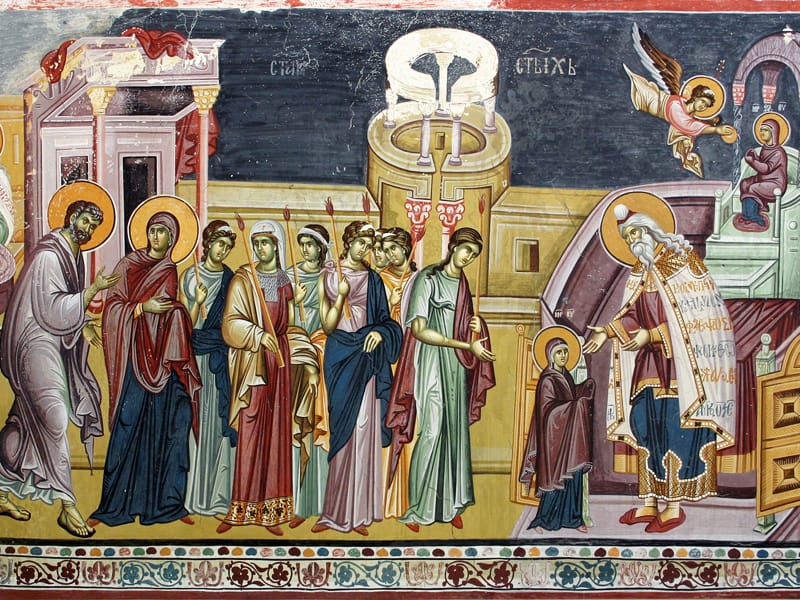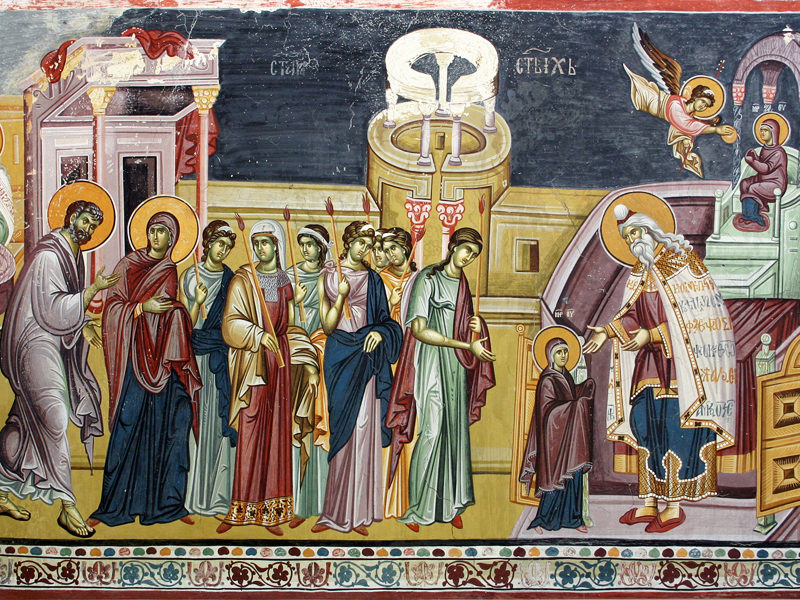
In the Greek Orthodox Church, the Presentation of the Theotokos is celebrated on November the 21st.
According to Church Tradition Panagia's parents, Joachim and Anna took her to the Temple in Jerusalem as a young girl, where she was presented to the high priest Zacharias, father of St John the Baptist.
She lived there until her betrothal to St Joseph.
This feast marks the replacement of the Temple in Jerusalem as the physical dwelling place of God.
And the Theotokos replaces the Ark of the Covenant and becomes the Ark of the New Covenant, whose womb will carry Our Lord, Jesus Christ.
The Theotokos is truly the mother of God.
Theotokos usually translated into English as Mother of God literally translates as "God Bearer", meaning she carried God in her womb and that Jesus Christ is indeed God, one of the Holy Trinity.
The Entrance of the Ever-Virgin Mary and Theotokos in God’s Temple is considered to be one of the most important events in the History of Salvation. All the Orthodox Churches around the world celebrate the Entrance of the Mother of God, the Theotokos and Ever-Virgin Mary, into the Holy of Holies.
The Entrance of the Ever-Virgin Mary consist the preparation of the salvation of mankind. She enters the Holy of Holies, where only the High Priest was allowed to enter only once a year. The Prophet Zacharias, the father of St John the Forerunner and Baptist, and many young virgins receive Mary when she was only three years of age, dedicated to God by Her parents Joachim and Anna.
The Mother of God, Mary, enters the Holy of Holies, where She was honored to become the living Ark and Temple of God.

The Virgin was clad in vesture of royal magnificence and adornments as was befitting the “King’s daughter, the Bride of God” (Psalm 45:13-15). Following them were many kinsmen and friends, all with lighted tapers. Fifteen steps led up to the Temple. Joachim and Anna lifted the Virgin onto the first step, then she ran quickly to the top herself, where she was met by the High Priest Zacharias, who was to be the father of St. John the Forerunner.
Taking her by the hand, he led her not only into the Temple, but into the “Holy of Holies,” the holiest of holy places, into which no one but the high priest ever entered, and only once each year, at that. St. Theophylact of Ohrid says that Zacharias “was outside himself and possessed by God” when he led the Virgin into the holiest place in the Temple, beyond the second curtain – otherwise, his action could not be explained. Mary’s parents then offered sacrifice to God according to the Law, received the priest’s blessing and returned home.
The Most-holy Virgin remained in the Temple and dwelt there for nine full years. While her parents were alive, they visited her often, especially Righteous Anna. When God called her parents from this world, the Most-holy Virgin was left an orphan and did not wish to leave the Temple until death or to enter into marriage.
As that would have been against the Law and custom of Israel, she was given to St. Joseph, her kinsman in Nazareth, after reaching the age of twelve. Under the acceptable role of one betrothed, she could live in virginity and thus fulfill her desire and formally satisfy the Law, for it was then unknown in Israel for maidens to vow virginity to the end of their lives. The Most-holy Virgin Mary was the first of such life-vowed virgins, of the thousands and thousands of virgin men and women who would follow her in the Church of Christ.
Celebration of the Feast
During the Divine liturgy the Epistle reading is from Hebrews 9:1-7
1 Then verily the first covenant had also ordinances of divine service, and a worldly sanctuary.
2 For there was a tabernacle made; the first, wherein was the candlestick, and the table, and the shewbread; which is called the sanctuary.
3 And after the second veil, the tabernacle which is called the Holiest of all;
4 Which had the golden censer, and the ark of the covenant overlaid round about with gold, wherein was the golden pot that had manna, and Aaron's rod that budded, and the tables of the covenant;
5 And over it the cherubims of glory shadowing the mercyseat; of which we cannot now speak particularly.
6 Now when these things were thus ordained, the priests went always into the first tabernacle, accomplishing the service of God.


